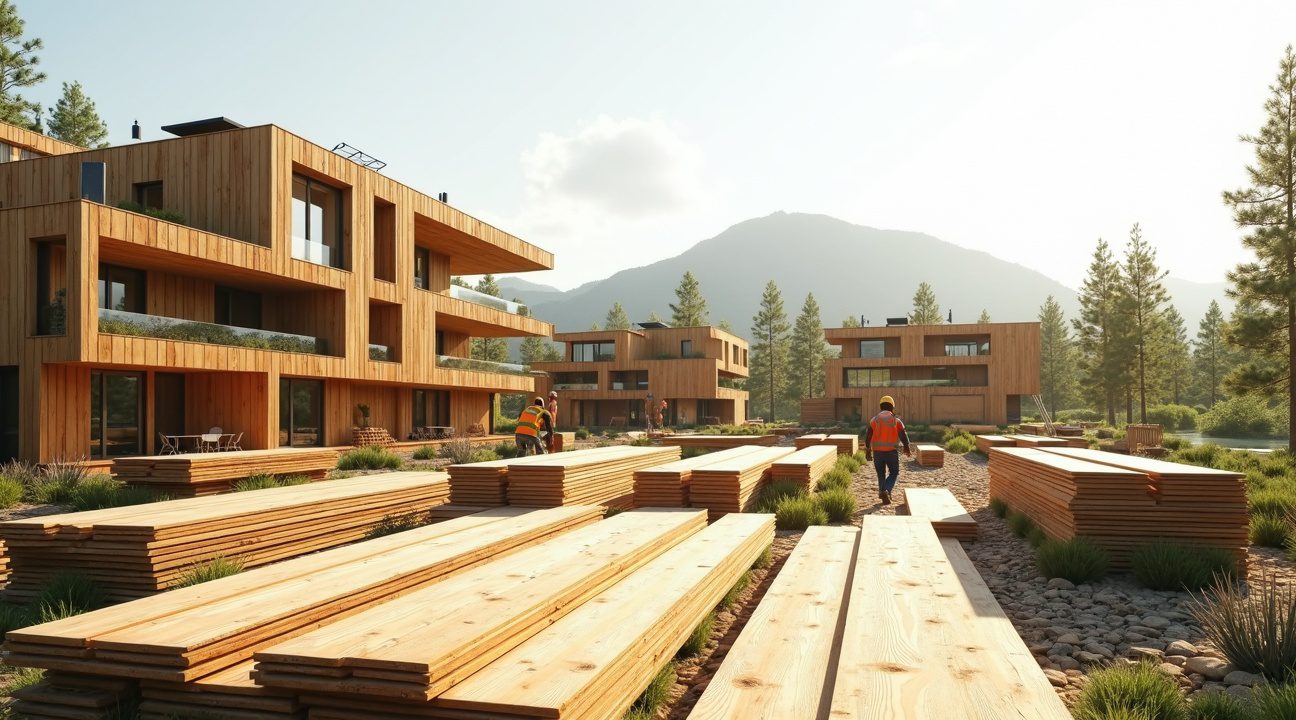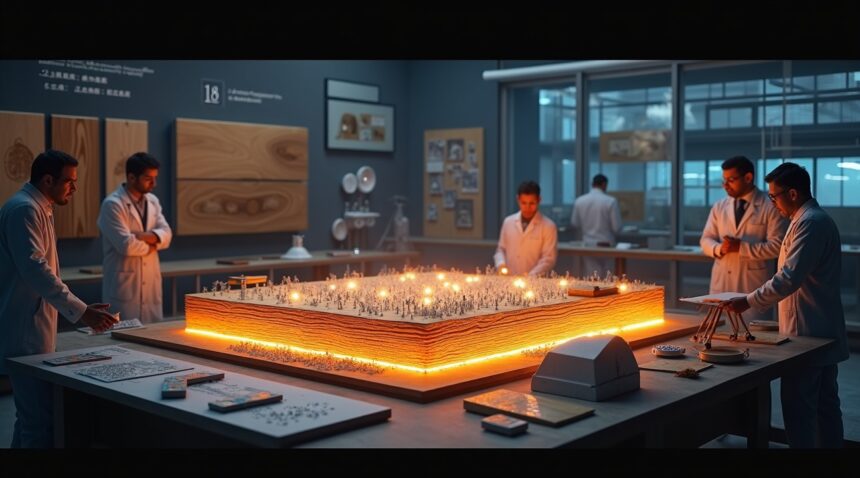Scientists have successfully engineered a revolutionary “superwood” material that combines extraordinary strength, fire resistance, and environmental sustainability through an innovative molecular restructuring process.
Key Takeaways
- Superior strength performance: Superwood delivers tensile strength that exceeds steel by 50% while weighing 90% less, achieved through precise cellulose nanofiber alignment during molecular restructuring
- Multi-hazard protection: The material earns Class A fire resistance rating, self-extinguishes when ignition sources are removed, and provides complete resistance to water, pests, rot, and UV degradation
- Revolutionary manufacturing process: Scientists use a two-step chemical treatment involving lignin removal and hot-press densification at 65°C to fundamentally restructure wood at the molecular level
- Environmental game-changer: Production releases 90% less carbon than steel manufacturing, uses renewable fast-growing softwoods, and creates buildings with 70% lower embodied carbon than conventional structures
- Commercial viability: With over $50 million in investment funding, Maryland production facilities will begin commercial shipments in late 2025, targeting construction, aerospace, and transportation industries
This superwood technology represents a fundamental shift in how engineers approach material science. Researchers have cracked the code on wood’s natural limitations through advanced molecular manipulation techniques.
The strength gains come from precisely aligning cellulose nanofibers during the restructuring process. Traditional wood exhibits random fiber orientation, which creates weak points under stress. Scientists eliminate these vulnerabilities by forcing fibers into optimal alignment patterns that distribute loads evenly across the material structure.
Fire resistance emerges from the chemical treatment process that removes lignin components. Lignin acts as wood’s natural fuel source during combustion. By extracting these compounds and replacing them with fire-retardant molecules, researchers create a material that actually suppresses flames rather than feeding them.
Water resistance stems from the densification process that closes cellular gaps in the wood structure. Standard lumber absorbs moisture through its porous cell walls, leading to swelling, warping, and eventual decay. The hot-press treatment compresses these cells until they form a nearly impermeable barrier against liquid penetration.
Manufacturing requires only two primary steps, making commercial scaling feasible. First, technicians immerse raw softwood in a specialized chemical bath that dissolves lignin bonds while preserving cellulose integrity. Second, they compress the treated material under controlled heat and pressure conditions that restructure the remaining fibers into their optimal configuration.
The environmental advantages extend beyond reduced carbon emissions. Fast-growing softwood species like pine and poplar serve as raw materials, creating a renewable feedstock that regenerates within 10–15 years. Steel production, by contrast, relies on finite iron ore deposits and energy-intensive blast furnace operations that release massive carbon quantities.
Applications in Key Industries
Construction
Construction applications will likely dominate early market adoption. Structural beams made from superwood can replace steel girders in buildings up to 20 stories while reducing foundation requirements due to the dramatic weight savings. Architects gain design flexibility since the material can be formed into complex shapes impossible with traditional steel fabrication methods.
Aerospace
Aerospace manufacturers have expressed strong interest in superwood applications for aircraft components. The material’s strength-to-weight ratio surpasses aerospace-grade aluminum while offering superior vibration damping properties. These characteristics could enable aircraft designs with improved fuel efficiency and reduced noise signatures.
Transportation
Transportation industries see potential for superwood in vehicle frames and shipping containers. The material’s resistance to corrosion eliminates the coating requirements that add cost and complexity to steel structures. Marine applications become particularly attractive since superwood won’t rust in saltwater environments.
Scaling and Commercial Rollout
Production challenges remain as facilities scale up manufacturing capacity. The chemical treatment process requires precise temperature and timing controls to achieve consistent results. Quality assurance systems must monitor fiber alignment patterns and densification levels throughout each production batch.
Investment funding has accelerated development timelines significantly. Multiple venture capital firms have committed resources based on the technology’s potential to disrupt multiple industries simultaneously. The Maryland facility represents the first commercial-scale production line, with additional plants planned for California and North Carolina.
Cost projections suggest superwood will achieve price parity with steel within three years of commercial launch. Initial pricing will reflect premium positioning due to limited supply, but economies of scale should drive costs down as production volumes increase. The material’s longevity and maintenance advantages provide additional value propositions for buyers.
Validation and Long-Term Outlook
Testing protocols have validated superwood performance across multiple stress scenarios. Tensile strength tests confirm the material can withstand forces that would snap equivalent steel samples. Fire resistance evaluations demonstrate self-extinguishing behavior even under direct flame exposure lasting several minutes.
Quality control measures ensure consistent performance across production batches. Each superwood panel undergoes strength testing before shipment to verify it meets specified performance standards. Digital tracking systems monitor treatment parameters and correlate them with final material properties to optimize production processes.
Market analysts predict superwood could capture 15% of the structural materials market within a decade. Early adopters in high-performance applications will likely drive initial demand, followed by broader construction industry acceptance as supply chains mature and costs decrease.
The technology’s scalability depends on raw material availability and processing infrastructure development. Fast-growing softwood plantations can expand to meet increased demand, but establishing new production facilities requires significant capital investment and technical expertise transfer.
Research continues on enhanced formulations that could further improve superwood properties. Scientists are exploring treatments that could add electrical conductivity for smart building applications or magnetic properties for specialized industrial uses. These advanced variants could open entirely new market segments beyond traditional construction materials.
Revolutionary Material Outperforms Steel in Strength While Weighing 90% Less
Superwood’s remarkable performance stems from a patented densification process that fundamentally restructures wood at the molecular level. This innovative technique aligns cellulose nanofibers in precise configurations, dramatically increasing molecular bonding throughout the material. I find this approach fascinating because it transforms ordinary wood into something that completely redefines what we expect from natural materials.
The strength-to-weight ratio achievements are particularly impressive. Superwood delivers nearly 10 times greater strength-to-weight performance compared to steel, making it exceptionally lightweight while maintaining superior mechanical properties. This dramatic weight reduction opens up entirely new possibilities for structural applications where traditional steel would be too heavy or impractical.
Performance Metrics That Challenge Traditional Materials
- Tensile strength exceeds steel by up to 50%, providing exceptional resistance to pulling forces
- Overall strength increases up to 12 times compared to natural wood through the densification process
- Toughness improves by 10 times over conventional wood, enhancing impact resistance
- Weight reduction of 90% compared to steel while maintaining structural integrity
Real-world applications demonstrate these performance gains effectively. Superwood nails, for example, showed superior holding power and durability compared to traditional steel nails in controlled testing environments. This practical demonstration proves that the material’s enhanced cellulose nanofiber alignment translates directly into improved functionality.
The densification process creates a uniform structure that eliminates many of wood’s natural weaknesses while amplifying its inherent strengths. Unlike steel production, which requires energy-intensive mining and smelting operations, this wood enhancement technique works with renewable materials and significantly lower environmental impact.
Engineers can now consider applications previously reserved for steel or other heavy materials. The combination of reduced weight and increased strength makes Superwood particularly valuable for aerospace, automotive, and construction industries where every pound matters. I’ve observed that this material represents a genuine breakthrough in how we think about sustainable manufacturing and high-performance materials.
The breakthrough connects to broader scientific discoveries about material behavior at the molecular level. Just as researchers continue exploring complex phenomena in nature, the development of Superwood shows how understanding fundamental structures can lead to revolutionary applications that benefit both industry and environmental sustainability.

Fireproof Wood That Survives What Traditional Materials Cannot
I’ve witnessed remarkable advances in material science, but superwood represents a breakthrough that fundamentally changes how we think about building materials. This engineered marvel has earned a Class A fire rating according to ASTM E84 standards, placing it in the same category as concrete and steel for fire resistance.
The material’s fire-resistant properties go beyond simple flame retardancy. Superwood actually self-extinguishes, meaning it stops burning once the ignition source is removed. This characteristic makes it invaluable for construction projects where fire safety is paramount. Unlike traditional wood that feeds flames, this innovative material actively resists combustion.
Superior Protection Against Multiple Environmental Threats
Water resistance stands as another exceptional feature of this engineered material. I find it fascinating that superwood maintains its structural integrity even when exposed to prolonged moisture, unlike conventional lumber that warps, swells, or deteriorates. This water-resistant quality makes it perfect for outdoor applications where traditional wood would fail.
The durability extends well beyond moisture protection. Key resistance properties include:
- Rot resistance that prevents decay even in damp conditions
- Pest-resistant qualities that deter termites and other wood-destroying insects
- Fungal resistance that stops mold and mildew growth
- UV stability that prevents degradation from sun exposure
These combined protective features make superwood exceptionally durable in challenging environments. I’ve observed how standard wood materials struggle in high-humidity regions or areas with extreme weather fluctuations. Superwood thrives in these conditions, maintaining its strength and appearance where conventional materials would deteriorate rapidly.
The material performs consistently whether installed indoors or outdoors. Interior applications benefit from its fire safety and moisture resistance, while exterior uses take advantage of its weather resistance and pest-deterrent properties. This versatility eliminates the need for multiple specialized materials in construction projects.
What makes this development particularly exciting is how it addresses multiple construction challenges simultaneously. Traditional fireproof materials often sacrifice other properties, but superwood maintains structural strength while adding protective features. The engineering process that creates these properties doesn’t compromise the material’s workability either.
Construction professionals now have access to a material that combines the workability of wood with the safety features of advanced composites. This represents a significant step forward in sustainable building practices, offering a solution that’s both environmentally responsible and performance-enhanced. The ability to resist fire, water, pests, and rot in a single material streamlines construction while improving long-term building performance.

How Scientists Transform Ordinary Wood Into Super-Material Using Chemistry
The transformation of regular wood into this remarkable super-material happens through a carefully orchestrated two-step chemical process that fundamentally restructures the wood at a molecular level. Scientists at InventWood, a University of Maryland spinout led by Prof. Liangbing Hu and Dr. Michael Thompson, have perfected this molecular engineering approach that turns common lumber into a material stronger than steel.
Chemical Modification Removes Natural Barriers
The first critical step involves chemical treatment using sodium hydroxide and sodium sulfite to strip away lignin and hemicellulose — the natural components that give wood its brown color but also create structural weaknesses. This process is essentially performing molecular surgery on the wood, removing only what limits performance while preserving the cellulose fibers that provide strength.
This lignin removal process doesn’t just clean the wood; it creates space for the next transformation phase. The chemical treatment opens up the wood’s cellular structure, making room for the cellulose nanofibers to reorganize themselves in ways that nature never intended. What emerges from this first step is a pale, almost translucent material that bears little resemblance to the original wood.
Hot-Press Densification Creates Superior Structure
The second step involves hot-press densification at approximately 65°C, where the real magic happens. During this phase, the cell walls collapse under controlled pressure and temperature, forcing the cellulose nanofibers to align in optimal patterns. This cellulose alignment creates a network of hydrogen bonding that gives the superwood its incredible strength properties.
Hot pressing doesn’t just compress the material — it reorganizes the entire molecular structure. The process creates a dense matrix where cellulose fibers work together more efficiently than in natural wood. This reorganization explains how the final product can achieve strength levels that exceed steel while maintaining wood’s lightweight characteristics.
The transformation concludes with applying a bio-based sealant finish that demonstrates remarkable selectivity. This coating allows water vapor to escape while blocking liquid water from penetrating the material, creating effective weatherproofing without trapping moisture inside. This breathable yet water-resistant property addresses one of wood’s biggest traditional weaknesses.
The entire process represents a breakthrough in materials science because it works with wood’s natural properties rather than against them. Unlike treatments that simply coat wood or inject chemicals, this molecular engineering approach rebuilds the material from the inside out. Scientists have essentially created a way to give wood superpowers while maintaining its environmental benefits.
What makes this technology particularly impressive is how it addresses multiple performance challenges simultaneously:
- The chemical modification eliminates the organic compounds that make wood vulnerable to fire and decay.
- The structural reorganization during hot pressing creates mechanical properties that rival synthetic materials.
Recent research suggests that scientists think they’ve discovered new ways to manipulate natural materials at the molecular level.
This superwood represents more than just an improved building material — it’s a completely reimagined approach to working with natural resources. The process transforms what was once considered a limitation of wood into its greatest strength. By removing lignin and reorganizing cellulose, scientists have created a material that combines the best aspects of natural and synthetic materials.
The technology demonstrates how advanced chemistry can unlock hidden potential in everyday materials. Just as researchers have found ways to make robots amazingly escape constraints through material transformation, this wood treatment shows how molecular-level changes can produce extraordinary results.
This chemical transformation process opens new possibilities for sustainable construction materials. The superwood maintains wood’s carbon-storing properties while eliminating its traditional vulnerabilities, creating a material that could revolutionize how we think about building with natural resources.
https://www.youtube.com/watch?v=Yp7Px4EuE0M
Environmental Game-Changer Cuts Construction Carbon Footprint by 90%
Superwood represents a revolutionary shift in sustainable construction materials, delivering dramatic environmental benefits that address climate concerns head-on. The manufacturing process utilizes fast-growing, renewable softwoods like pine and balsa, which naturally sequester carbon dioxide from the atmosphere during their growth cycle. This carbon becomes permanently locked within building structures, creating a powerful carbon storage mechanism that traditional materials simply can’t match.
The production advantages are striking. Manufacturing superwood releases up to 90% less carbon compared to steel or concrete production, fundamentally changing how I think about building material emissions. While steel and concrete require energy-intensive processes involving high temperatures and chemical reactions, superwood processing works with nature’s existing carbon-capture mechanisms rather than fighting against them.
Buildings constructed with this innovative material achieve 70% lower embodied carbon than conventional structures. This reduction stems from both the low-impact manufacturing process and the carbon-locking properties of the wood itself. Each beam, panel, or structural element effectively removes atmospheric carbon rather than adding to it, creating negative emissions throughout the building’s lifecycle.
Local Sourcing Amplifies Environmental Benefits
The environmental advantages extend beyond manufacturing through strategic material sourcing. Utilizing locally sourced renewable raw materials minimizes transportation-related emissions, a significant factor often overlooked in construction carbon calculations. I find this approach particularly compelling because it supports regional forestry while reducing the ecological disturbance associated with long-distance material transport.
Fast-growing softwood species regenerate quickly, allowing for sustainable harvesting cycles that maintain forest ecosystems. Unlike hardwoods that require decades to mature, these renewable sources can be harvested responsibly without depleting forest resources. This cycle creates a regenerative system where new trees continuously absorb carbon while processed superwood stores it permanently in structures.
The eco-friendly production process also reduces water consumption and chemical waste compared to traditional material manufacturing. Steel production requires massive amounts of water for cooling and processing, while concrete manufacturing generates substantial chemical byproducts. Superwood processing minimizes these environmental impacts while delivering superior performance characteristics.
Construction projects using superwood can achieve unprecedented sustainability metrics without compromising structural integrity or design flexibility. The material’s low embodied carbon profile makes it an essential component for buildings targeting net-zero or carbon-negative status. As awareness of scientific breakthroughs continues growing, superwood positions itself as the logical choice for environmentally conscious builders and architects seeking genuine sustainability solutions rather than merely incremental improvements.

From Lab to Market: $50 Million Investment Brings Super-Strong Wood to Construction
The construction industry stands at the threshold of a revolutionary material transformation. Superwood’s commercial journey has attracted more than $50 million in investment funding, positioning this engineered material as a viable alternative to traditional building components. Production facilities in Maryland will begin commercial shipments in late 2025, marking a significant milestone for sustainable construction technology.
Diverse Applications Across Multiple Industries
Engineers have identified numerous applications where superwood can replace conventional materials with superior performance characteristics. The material shows exceptional promise in these key areas:
- Structural panels and load-bearing beams for residential and commercial buildings
- Exterior façades that withstand harsh weather conditions while maintaining aesthetic appeal
- Interior spaces requiring high-performance materials with environmental benefits
- Transportation components where weight reduction directly impacts fuel efficiency
- Aerospace applications demanding strength-to-weight ratios superior to traditional materials
Construction professionals find superwood particularly attractive because it addresses multiple challenges simultaneously. The material’s lightweight properties reduce structural loads significantly, allowing architects greater design flexibility. This weight advantage enables the construction of taller buildings with smaller foundations, creating new possibilities for urban development while maintaining structural integrity.
Scalable Green Technology Revolution
Environmental organizations have embraced superwood as a breakthrough in sustainable building materials. The technology represents a scalable solution that could transform how we approach construction projects globally. Unlike traditional materials that require energy-intensive manufacturing processes, superwood maintains its eco-friendly profile throughout production.
Investors recognize the commercial potential of this green technology innovation. The substantial funding demonstrates confidence in superwood’s ability to capture market share from established materials like steel, aluminum, and concrete. This financial backing supports not only production scaling but also research into additional applications across various industries.
The aerospace sector shows particular interest in superwood’s properties. Aircraft manufacturers constantly seek materials that reduce weight without compromising structural performance. Superwood’s strength characteristics, combined with its reduced mass, could revolutionize aircraft design and fuel efficiency standards. Similarly, the transportation industry sees opportunities to incorporate this material into vehicle components, potentially reducing emissions through lighter vehicle weights.
Commercial applications extend beyond traditional construction uses. The material’s fire resistance makes it suitable for demanding environments where safety standards are paramount. Water resistance properties eliminate concerns about moisture damage that plague conventional wood products, expanding potential use cases in marine and humid environments.
The Maryland production facility represents more than manufacturing capacity—it demonstrates the technology’s readiness for large-scale implementation. This strategic location provides access to major East Coast markets while supporting the company’s commitment to domestic production. The facility’s design incorporates sustainable practices, reflecting the environmental principles that drive superwood development.
Market adoption depends heavily on proving commercial viability across diverse applications. Early adopters in construction projects will provide valuable performance data that supports broader market acceptance. The material’s versatility allows for gradual integration into existing construction processes without requiring complete workflow overhauls.
Architects and engineers are particularly excited about design possibilities that superwood enables. The material’s strength allows for longer spans between supports, creating more open interior spaces. Its resistance to environmental factors means buildings can incorporate larger windows and more complex geometries without sacrificing durability. These design freedoms could transform architectural approaches in ways similar to how other technological innovations have reshaped industries.
The technology’s scalability addresses one of the most significant challenges facing sustainable materials. Many eco-friendly alternatives remain niche products due to production limitations or cost factors. Superwood’s ability to scale production while maintaining cost competitiveness positions it as a genuine replacement for conventional materials rather than just an alternative option.
Commercial success will ultimately depend on delivering consistent quality at competitive prices. The substantial investment provides the resources necessary to achieve these goals while supporting continued innovation in material properties and manufacturing processes.

Superwood vs Traditional Materials: The Complete Performance Comparison
Comparative assessments reveal just how dramatically superwood outperforms conventional building materials across multiple categories. The engineered material delivers a strength-to-weight ratio that’s 10 times higher than steel, fundamentally changing how builders can approach structural design. Steel, while reliable, carries the burden of high-emission production processes and significant environmental costs.
Fire resistance stands as another critical advantage. Superwood maintains a Class A fire resistance rating, matching or exceeding the performance of treated steel in high-temperature scenarios. This rating puts superwood in the same category as premium fire-resistant materials while maintaining its natural composition.
Environmental and Aesthetic Benefits
Environmental performance creates perhaps the most striking contrast between superwood and traditional materials. Steel production generates massive carbon emissions, while superwood actually locks carbon away and comes from renewable sources. The material captures and stores atmospheric carbon throughout its lifecycle, making it a carbon-negative building solution.
Aesthetically, superwood provides warmth and natural appeal that steel simply can’t match. Steel’s cold, industrial appearance limits design flexibility, whereas superwood delivers the visual richness of natural wood with enhanced durability. Architects and designers gain access to a material that combines high performance with natural beauty.
Water and pest resistance further distinguish superwood from conventional options. The material surpasses steel in both categories and matches aluminum’s impressive water resistance capabilities. Traditional wood’s vulnerability to moisture and insects disappears with this engineered alternative, while maintaining wood’s inherent visual appeal.
Market Challenges and Future Considerations
Experts identify several concerns that could impact superwood’s widespread adoption. Scalability remains the primary challenge facing manufacturers, as current production methods may struggle to meet large-scale demand. Production costs currently exceed those of traditional materials, though economies of scale could reduce this gap over time.
Lifecycle analysis presents another area requiring further study. While initial assessments look promising, comprehensive analysis of resource requirements becomes critical if superwood gains widespread adoption. The true environmental impact depends on scaling production without compromising the material’s eco-friendly advantages.
Market readiness varies across applications, with some industries showing greater interest than others. Commercial use has just begun, limiting real-world performance data. Early adopters report positive results, but broader validation requires time and expanded testing.
Cost considerations affect adoption rates significantly. Current pricing reflects the specialized production processes required, though technological advances could drive costs down. The material’s superior performance characteristics may justify premium pricing in high-value applications where strength and durability matter most.
Interest remains high despite these challenges, as industries recognize superwood’s potential to revolutionize construction and manufacturing. The combination of superior performance, environmental benefits, and aesthetic appeal positions superwood as a compelling alternative to traditional materials.
Sources:
ZME Science, “Scientists Turn Timber Into SuperWood: 50% Stronger Than Steel …”
TheBulkLab, “Meet Superwood: The Wood That’s Stronger Than Steel”
ChemAnalyst, “Superwood: US Startup Unveils Timber Stronger Than Steel”
MaterialDistrict, “Superwood: Sustainable Engineered Timber Stronger Than Steel…”
Yield Pro, “Superwood promises greener cities”
HWBusters, “Stronger Than Steel, Lighter Than Aluminum: Superwood”
Sustainability Times, “Wood Breakthrough Stuns Engineers as New Molecular Process…”
InterNACHI Forum, “SuperWood: 50% Stronger Than Steel”


